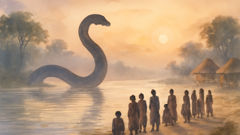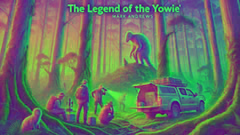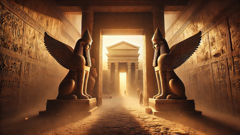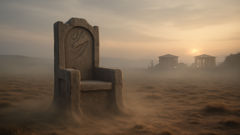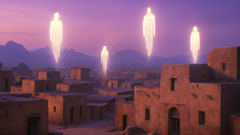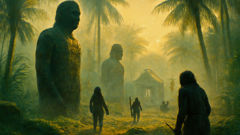Introduction
On the banks where the Zambezi wears its years in glassy light, the people have learned to listen to the river as if it were a living elder. They tell stories in the hush of dawn, when the mist still clings to the baobabs and the birds sound their notes in a chorus older than the village drums. In these stories, Nyami Nyami—the river’s great serpent—moves with the gravity of the seasons, a guardian whose scales catch the sun and whose breath makes the current go soft or surge like a heartbeat. To the elders, Nyami Nyami is not merely a god of flood and drought; he is a patient witness, a partner in the daily work of living: fishing, farming, and the stubborn, hopeful arithmetic of keeping a family fed when the river changes its mind. The Nyami Nyami is said to have a wife, Nyaminyami, whose own memory runs like a silver thread through the river’s red clay shores. They share a life that is as intimate as the night sky and as vast as the water itself, a memory that becomes a map for travellers, a warning for those who would tempt the river’s patience, a promise for the generations who must learn to live with water’s mercy and its fury. When the Kariba Dam rose from the earth with the rumble of a storm breaking a hill, the river changed its voice. Concrete piers punched the sky, sluice gates roared awake, and the old songs—the ones that spoke of the river’s language—began to sound like a foreign alphabet to the people who stood on the shore with their baskets and their questions. The dam altered not only the course of the river but the shape of memory. Nyami Nyami, beloved guardian of the valley, found himself parted from his mate by the very thing humans believed would tame the river: a barrier. Yet the current did not forget; it only learned new currents, and the old questions about love, protection, and belonging did not vanish with the water’s edge. This tale follows a village that refuses to surrender its legends even as the modern world—factories, roads, and hydroelectric schemes—press in with bright, sharp hulls. It asks what it means to be faithful to one’s river when the river has a new, unfamiliar geometry to navigate. It asks how a community can hold on to Nyami Nyami’s gaze when a dam’s shadow stretches farther every year. And it asks, most insistently, whether the gods still listen when the ground trembles with construction and the land smells of cement and promise. The legend becomes a living conversation, a kind of liturgy whispered by the river’s edge, carried in the breath of children who test the water’s depth with bare feet, and in the drumbeat of elders who keep the old songs alive in a world that keeps moving forward. In this long, patient listening, the Nyami Nyami learns anew to stretch his serpentine body along the river’s bend, to tilt his head toward the heart of the valley, to listen for the small verbs of care: the grandmother who seeds maize at the riverbank, the fisher who tunes his nets to the river’s whim, the young dancer who spins to imitate the river’s ripples. And the people, in turn, learn to listen for a different kind of telling—the way the river speaks in the rustle of reed mats, in the way the river’s shadow falls across the shebeen’s open door, in the way the dam’s distant hum becomes a layered orchestra that reminds them of home. The legend does not erase the dam; it asks us to see the dam as a new landscape within which old loyalties must navigate with the same patience Nyami Nyami has always shown. It is a story of weathered hands and bright hopes, of a river that refuses to be owned or silenced, of a god who remains, in the end, a guardian who teaches even the builders to hear the living world’s wisdom. And so, as long as the Zambezi flows and the valley holds its breath, the Nyami Nyami endures—watchful, loving, and enduring.
Section I: The River’s Voice
The river remembers, even when the river seems to forget. In the long days before the dam's mouth opened like a new century, Nyami Nyami moved with the river’s own mood—the way a lover follows a beloved’s steps, careful not to startle the other’s breath. The elders say Nyami Nyami was born from the river’s first sigh, a great serpent whose scales held the color of morning rain and whose eyes shone with the patience of the mountains. He did not call the river a boundary but a living corridor of stories, a place where people learned to listen before they spoke, to wait for the river’s own answer before casting a line or lighting a fire. The people of the valley learned to honor this watchful guardian with offerings of maize beer, songs threaded with the river’s name, and quiet prayers spoken between the clap of hands during the evening dances. Nyaminyami, his wife, appears in the memory of the water as a companion and a counterweight—tender, fierce, and unafraid of the river’s depth. When weather turned heavy and the drums grew louder, Nyami Nyami would coil his great form around the river’s bend, and the river would listen, its current aligning to his breath. They were a pair of a world that understood that life and water are not possessions but agreements: you respect the river, and the river will respect you back. The valley spoke in a language of rhythms—the beat of the kalimba, the cadence of a fisherman’s chant, the quiet arithmetic of planting before the storms. Children learned to say Nyami Nyami’s name softly, as if it might slip out of the mouth if spoken too loudly and wake the old gods. Then, in a breath that felt like a breaking dawn, the dam rose from the earth, a sharp, gleaming line that split the river’s long, patient narrative into before and after. The carpenters and engineers who built the Kariba Dam carried their own belief that they could measure time, that they could bend nature to a schedule. They did not always listen to the river they sought to tame, and so the river’s voice grew quieter at first, then began to speak in surges and pauses that sounded like a heartbeat under stone. Some nights, as the turbines began to hum and the valley cooled from the day’s heat, the water would tremble in ways the villagers could feel in their bones. It was as if Nyami Nyami and Nyaminyami were circling the new barrier, naming the space where the river had to learn a new language. In those years, the people learned to tell the river’s stories aloud, not as a superstition but as a map: keep the songs in your mouth, keep the nets mended, keep the children by the riverbank while the river speaks. The tale of Nyami Nyami is, at its heart, a reminder that guardianship is not a shield from loss but a vow to endure, to hold a lineage of memory even when the ground shifts and the water’s path becomes a thread that must be followed across a different loom. The section closes with a careful listening: the river speaks, and the people choose to hear, and Nyami Nyami keeps his vigil by the bend, where the old songs lie like stones waiting to be stepped upon by feet that still believe in the river’s mercy.
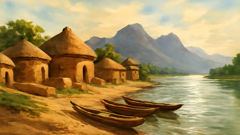
Section II: The Dam and the Quiet Distance
The dam rose like a city carved from stone, a monument to human ambition that believed it could rewrite weather and time with concrete and steel. To the valley, Kariba was a doorway to power and possibility—a source of electricity that would light schools and markets and bring progress to a region that had learned to live with scarcity. For Nyami Nyami, the dam was a new kind of river, a barrier that did not end the life of the river but altered its breathing. The great serpent watched as the earth rose beneath the river’s bed, as the sound of chisels and engines replaced the old river-whispers with a metallic choir. Nyaminyami did not vanish; she grew quieter, her face seen now only in the ripple of the water, a memory that clung to the surface like dew. The villagers, meanwhile, found themselves divided by a new geography. Some believed the river’s guardian would adapt, that the old laws could bend enough to allow Nyami Nyami to travel the river’s new rhythms. Others feared the separation would seal a rift between lovers and kin, that the river would forget the names of the people who had lived beside it for generations. Yet the river did not forget. In storms when the wind tore at the dam’s shadow and the water rose in a sudden, furious arc, the people felt a familiar quake in their chests. Nyami Nyami moved along the dam’s edge in their dreams, a distant form that shimmered with rain and reflected light from the turbines like a thousand small mirrors. The old stories began to shape new rituals: songs spoken to the towers, offerings cast toward the river in small boats that drifted beneath the dam’s dark face, prayers whispered in the gaps between machines and mountains. In the years that followed, a quiet courage settled into the valley—an understanding that guardianship does not always come with a single, dramatic gesture but with a patient, stubborn fidelity. Nyami Nyami learned to inhabit the space between the river’s old curve and the dam’s iron hinge, to stretch his presence across the width of a canals and gullies fed by water from a modern, restless river. The people learned to measure progress not in the height of a dam but in the depth of their memory: the songs saved, the nets mended, and the stories shared in the long, slow evenings when the lamps flickered in small huts and the river sounded its ancient call in the voice of the wind. storms and droughts came and went, but the valley’s belief persisted: the Nyami Nyami remained, a guardian who would not surrender his family or his people to the new machines; instead, he gave them a way to listen more deeply, to hold fast to what matters most when the world asks for new answers. The conclusion, a breath held in the heart of a river, comes not with triumph but with a promise: we will remember, we will tell the stories that keep the river’s heart beating, and we will learn to live with the river’s new language until the old songs return and the guardian’s gaze once again rests on the valley with the same patient, enduring mercy.
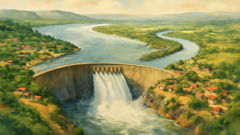
Conclusion
If the river could speak in a hundred voices, it would still return to Nyami Nyami and Nyaminyami the one word that binds them all: endure. The legend, inscribed in the elders’ voices and echoed by the river’s current, remains a living constitution of the valley. It teaches that power and progress must walk with humility, that guardianship survives not by domination but by listening, and that a community’s history is not a museum so much as a living, breathing partner in the daily acts of care. The Kariba Dam stands, yes—an emblem of modern achievement—but its shadow also carries the responsibility to remember that every floodgate opened, every turbine turned, changes a line in the river’s long song. So the people tell their children the story of Nyami Nyami again and again: not as myth alone, but as instruction in awe and responsibility. They teach their young to keep the river’s edges clear and to speak softly to the water, to leave small offerings of respect and gratitude for the guardians who guard not only the river’s wealth but the soul of the valley. And when the rains come and the river swells, they listen not only with fear but with recognition: the river is not conquered, it is asked to share its wisdom. Nyami Nyami’s gaze travels the bend, and in that gaze lies a quiet revolution: a promise that the past will be honored, that the present will be faced with courage, and that the future—whatever it holds—will be navigated together, as one people, one river, one story.

